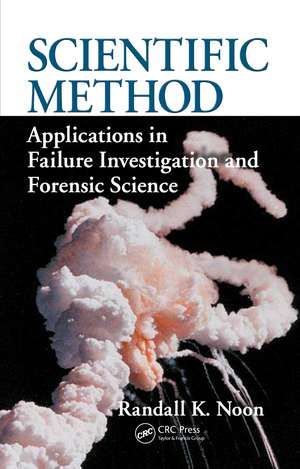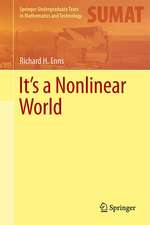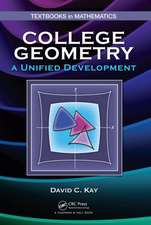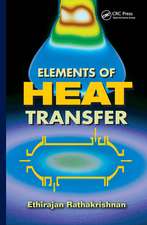Scientific Method: Applications in Failure Investigation and Forensic Science: International Forensic Science and Investigation
Autor Randall K. Noonen Limba Engleză Hardback – 27 apr 2009
While employing examples from forensic engineering, the book uses principles and ideas applicable to most of the forensic sciences. The author examines the role of the failure investigator, describes the fundamental method for investigation, discusses the optimal way to organize evidence, and explores the four most common reasons why some investigations fail. The book provides three case studies that exemplify proper report writing, contains a special chapter profiling a criminal case by noted forensic specialist Jon J. Nordby, and offers a reading list of resources for further study.
Concise and illustrative, this volume demonstrates how the scientific method can be applied to failure investigation in ways that avoid flawed reasoning while delivering convincing reconstruction scenarios. Investigators can pinpoint where things went wrong, providing valuable information that can prevent another catastrophe.
Din seria International Forensic Science and Investigation
- 9%
 Preț: 1250.11 lei
Preț: 1250.11 lei - 29%
 Preț: 1185.83 lei
Preț: 1185.83 lei - 18%
 Preț: 1120.55 lei
Preț: 1120.55 lei - 33%
 Preț: 866.73 lei
Preț: 866.73 lei - 18%
 Preț: 1113.12 lei
Preț: 1113.12 lei - 18%
 Preț: 1563.17 lei
Preț: 1563.17 lei - 15%
 Preț: 648.20 lei
Preț: 648.20 lei - 21%
 Preț: 459.98 lei
Preț: 459.98 lei - 15%
 Preț: 565.70 lei
Preț: 565.70 lei - 8%
 Preț: 547.67 lei
Preț: 547.67 lei - 15%
 Preț: 575.76 lei
Preț: 575.76 lei - 15%
 Preț: 461.55 lei
Preț: 461.55 lei - 22%
 Preț: 421.00 lei
Preț: 421.00 lei - 15%
 Preț: 535.51 lei
Preț: 535.51 lei -
 Preț: 356.44 lei
Preț: 356.44 lei - 15%
 Preț: 640.02 lei
Preț: 640.02 lei - 28%
 Preț: 821.53 lei
Preț: 821.53 lei
Preț: 1003.99 lei
Preț vechi: 1224.37 lei
-18% Nou
Puncte Express: 1506
Preț estimativ în valută:
192.17€ • 208.81$ • 161.53£
192.17€ • 208.81$ • 161.53£
Carte tipărită la comandă
Livrare economică 21 aprilie-05 mai
Preluare comenzi: 021 569.72.76
Specificații
ISBN-13: 9781420092806
ISBN-10: 1420092804
Pagini: 214
Ilustrații: 47 b/w images, 6 tables and less than 10
Dimensiuni: 156 x 234 x 18 mm
Greutate: 0.56 kg
Ediția:1
Editura: Taylor & Francis
Colecția CRC Press
Seria International Forensic Science and Investigation
Locul publicării:Oxford, United Kingdom
ISBN-10: 1420092804
Pagini: 214
Ilustrații: 47 b/w images, 6 tables and less than 10
Dimensiuni: 156 x 234 x 18 mm
Greutate: 0.56 kg
Ediția:1
Editura: Taylor & Francis
Colecția CRC Press
Seria International Forensic Science and Investigation
Locul publicării:Oxford, United Kingdom
Public țintă
Academic, Professional, and Professional Practice & DevelopmentCuprins
Introduction.The Fundamental Method. More about the Fundamental Method. Organizing Evidence. Four Common Reasons Why Some Investigations Fail. Report Writing: Three Case Studies. Misplaced Method in the Science of Murder. Reading List. Index.
.
.
Notă biografică
Randall K. Noon owns a consulting firm in Hiawatha, Kansas.
Recenzii
The well-organized text and excellent cause-and-effect tables and graphics make the subject matter very palatable while delivering a virtual investigation blueprint. If you are remotely interested in why something fails and how to prevent a recurrence, this book is not only a great read, but an absolute must for your personal maintenance Body of Knowledge!
— Ken Bannister, writing in Maintenance Technology
At the end of the day a forensic reconstruction is only as reliable as the science applied
to the data, which in turn is only as reliable as the data collected, documented, and preserved. This book goes a long way in preparing or reminding a person of their obligations as a forensic investigator in order to distinguish what is reliable science and what is prejudice, chance, or just a good guess.
—Dalton Brown, writing in MVC Forensics
— Ken Bannister, writing in Maintenance Technology
At the end of the day a forensic reconstruction is only as reliable as the science applied
to the data, which in turn is only as reliable as the data collected, documented, and preserved. This book goes a long way in preparing or reminding a person of their obligations as a forensic investigator in order to distinguish what is reliable science and what is prejudice, chance, or just a good guess.
—Dalton Brown, writing in MVC Forensics
Descriere
Focused primarily on forensic engineering, this volume explains how scientific investigative methods can best be used to determine why and how a particular failure occurred. Using principles and ideas that are applicable to most of the forensic sciences, the author examines the role of the failure investigator, discusses the optimal way to organize evidence, and explores the four most common reasons why some investigations fail. The book provides three case studies that exemplify proper report writing, contains a special chapter profiling a criminal case by noted forensic specialist Jon J. Nordby, and offers a reading list of resources for further study.









